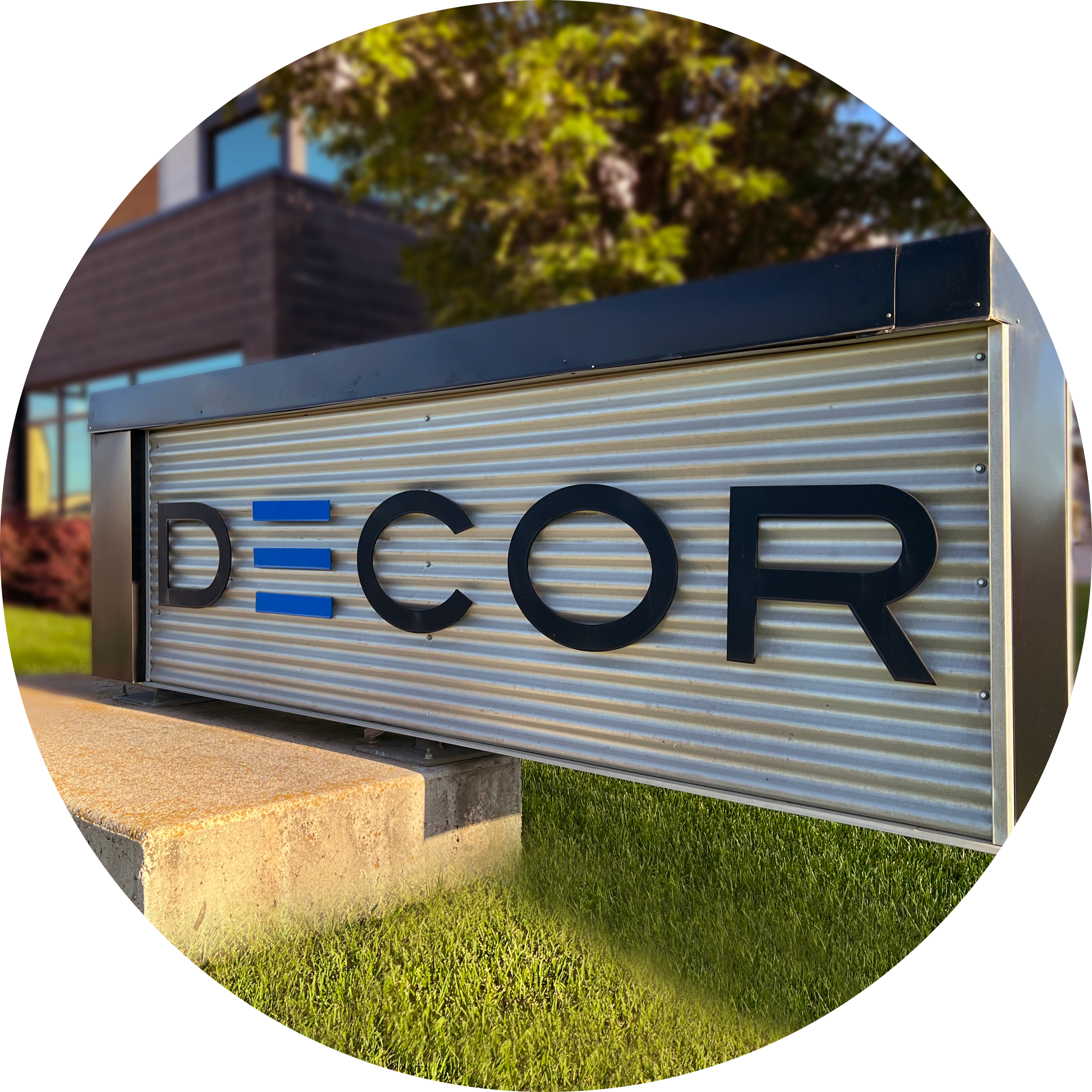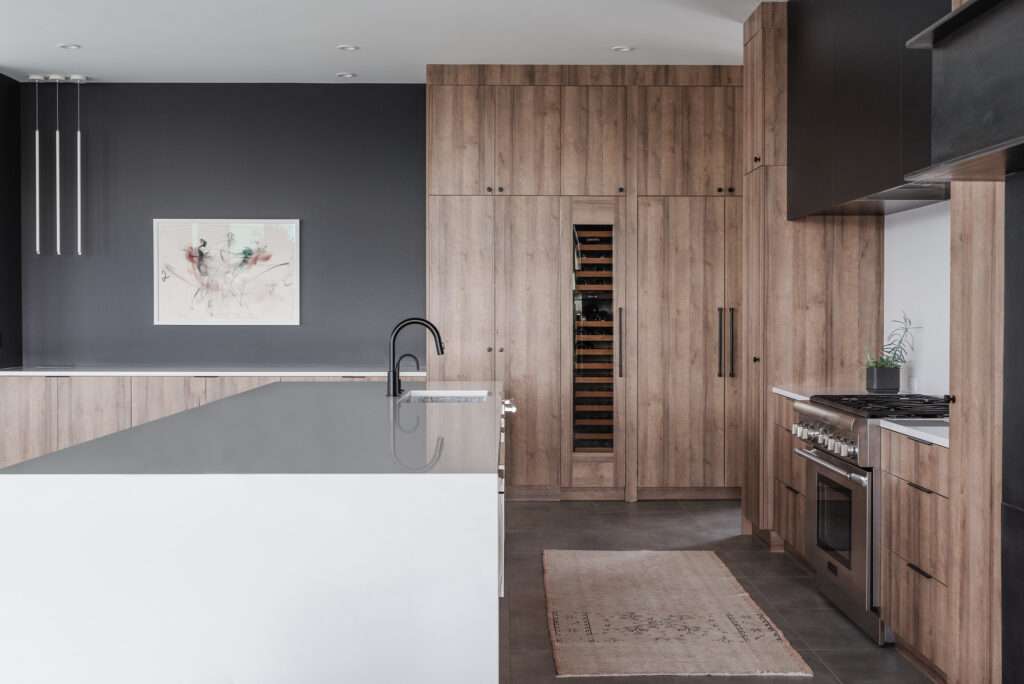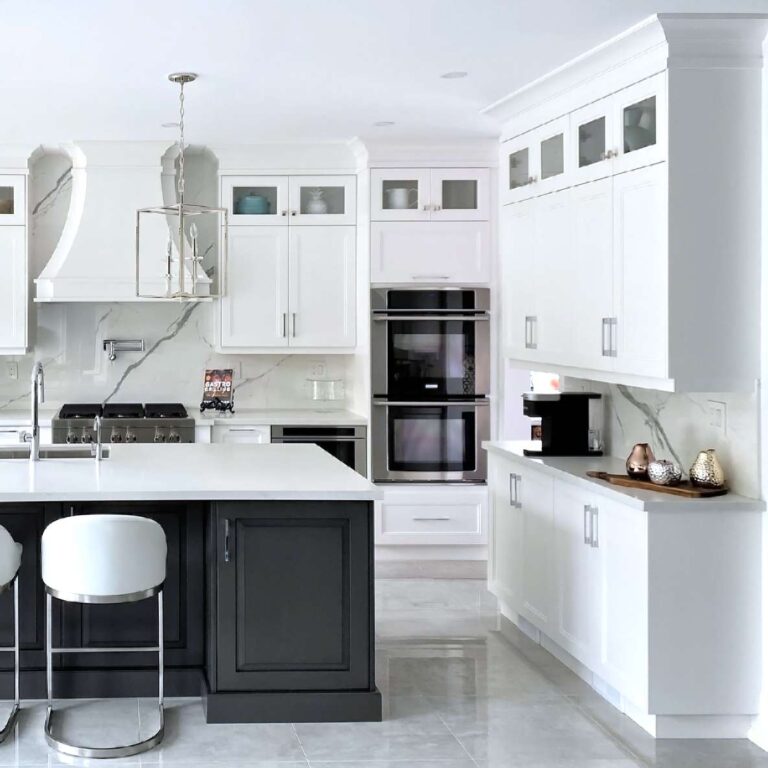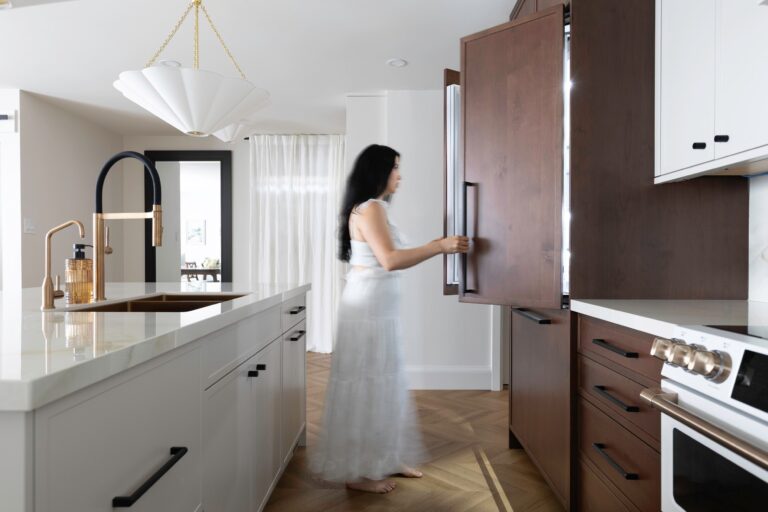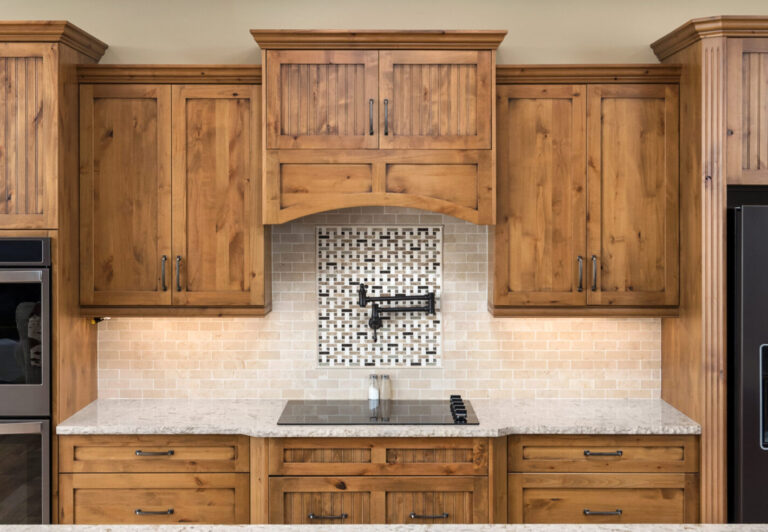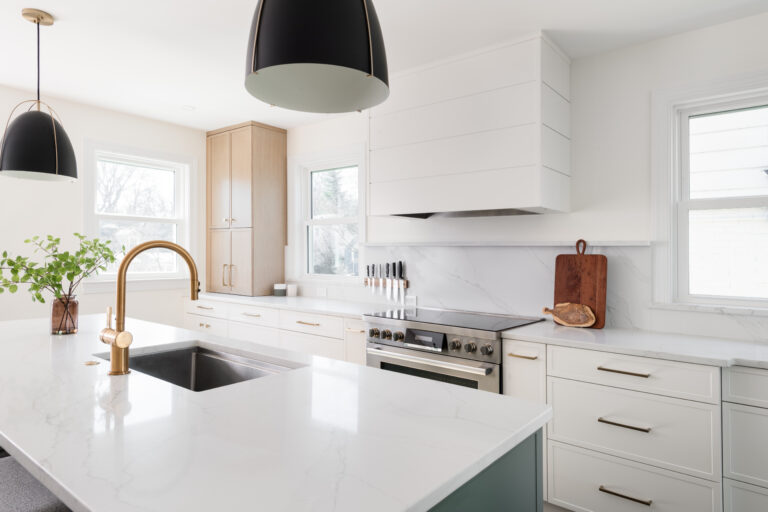Kitchen Countertops are the focal point of the kitchen and it’s what makes them complete. So choosing the right material is a big deal.
Deciding on which type of kitchen countertop material is the best for your kitchen depends on multiple variables to consider, some of which include durability, maintenance, and more.
Keep reading to find out which countertop best fits your kitchen design.
Types of Kitchen Countertops
Out of all the kitchen countertop types out there, we cover twenty of them in this article going through the materials, what they look like, and the pros and cons of each.
Let’s get right into it!
1. Laminate Countertops
At first, laminate was used as a tabletop surface in restaurants and cafés, then later took off in kitchens in the 1950s. It’s super popular today due to the price and number of patterns available.
The patterns give laminate countertops the ability to mimic other materials at a cost-effective price. So you could have a laminate countertop that looks like a marble countertop but for cheap. If your budget is tight, a laminate countertop is your best choice.
However, the downside is that laminate countertops have visible seams, which don’t always look so good depending on the pattern. Seams can also be a source of water penetration, and even more so if the installation isn’t done right.
Pros
- Budget-friendly
- Ease of installation due to weight
- Wide variety of colours, styles, textures, and patterns
- Stain resistant
- Maintenance free
Cons
- Not as durable as most other materials
- No heat resistance (possible delamination)
- Shorter lifespan compared to other materials
- Not repairable
If you want a deep dive into laminate countertops and their pros and cons, feel free to read up on our laminate countertops blog post.

2. Live Edge Kitchen Countertops
Live Edge Countertops (a.k.a. raw edge or raw wood countertops) give the kitchen a distinctly warm and welcoming feeling. They fit perfectly in any rustic or farmhouse kitchen!
The rich colour tones, knots, and complex wood grain patterns give it a special kind of warmth that will make you feel like your home is directly part of the forest and its natural beauty.
Live edge wood slabs are harvested from dead-standing trees and root systems on the forest floor, taking only what nature is already done with.
Pros
- Warm to the touch
- Elegant appearance
- Long lifespan due to the ability to resurface them multiple times
- Eco-Friendly
Cons
- High maintenance
- Humidity sensitive (wood expands and contracts with moisture levels – see our blog on understanding wood and moisture)
- Easily dents and scratches
- Not compatible with all household cleaners
If you think this one would fit your home, read our live edge countertops blog post.

3. Butcher Block Countertops
The best part about butcher block countertops is that they’re the only wooden countertop material that will barely warp. That’s because of the way they’re made.
The wood is kiln-dried and pre-sanded, so it’ll last years without warping. Afterward, it’s cut into straight cuts of wood, and glued together in slabs.
There are a number of hardwood types that can be used for butcher block countertops, some of which include maple, cherry, walnut, and oak. Softwood is typically avoided for wooden kitchen countertops because they’re prone to dents and scratches.
Pros
- Cost is not as cheap as laminate countertops, but not as expensive as natural stone
- The butcher block lasts about 20 years with regular maintenance
- The Butcher block countertop outlasts laminate countertops
- Can be sanded and resealed
- Eco-friendly countertop material
Cons
- Can absorb stains and bacteria
- No heat resistance; hot items placed on butcher blocks can scorch the wood
- Swells and shrinks with seasons
- High maintenance is required
Read more about butcher block countertops here on forbes.com
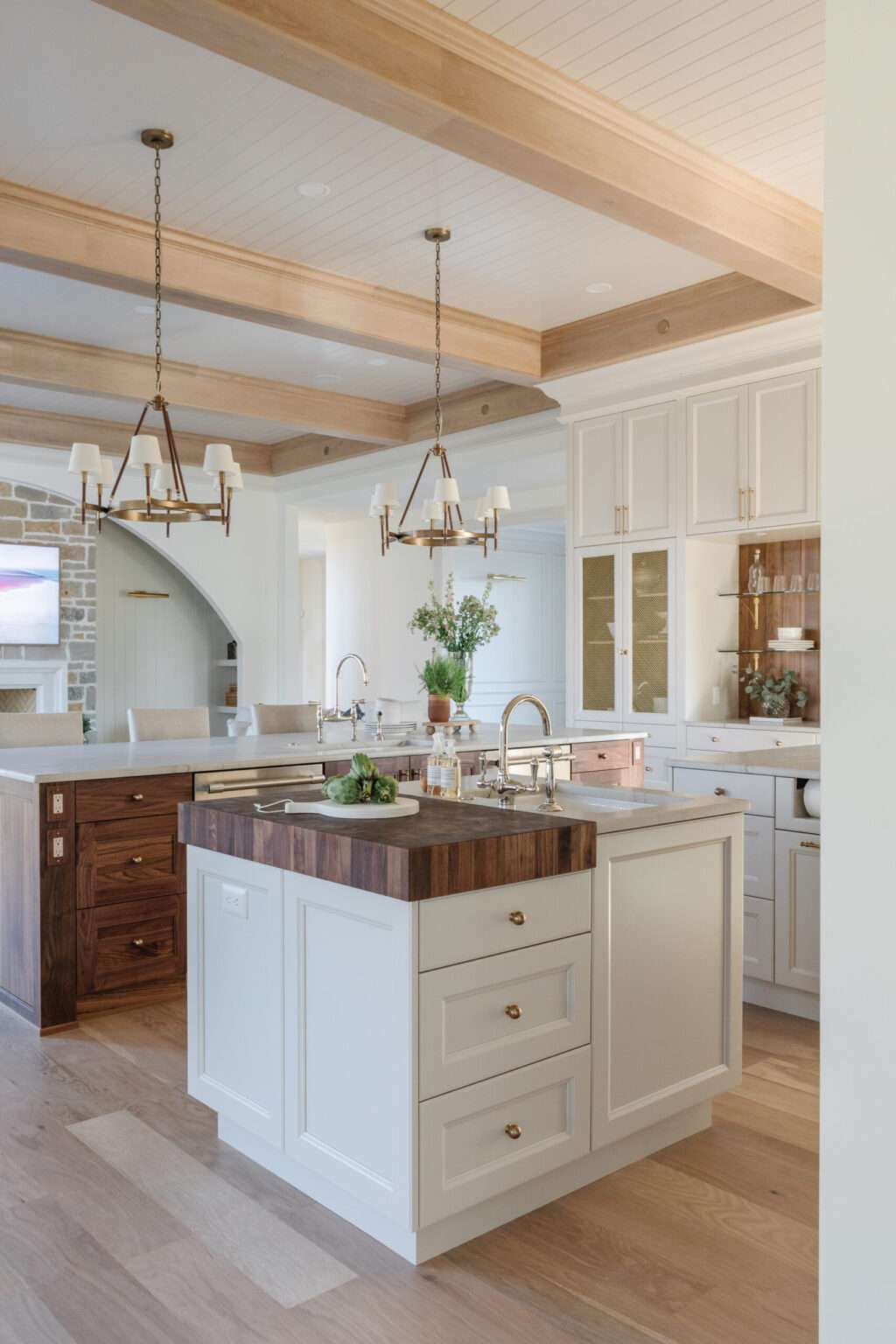
4. Bamboo Kitchen Countertops
Bamboo is often mistaken for another form of hardwood. In fact, it’s often grouped together with the general “solid-hardwood” category. Bamboo and hardwood have a similar look and feel, but some key differences set these two apart.
Even though bamboo is grouped together with hardwood, it’s not actually wood. Bamboo is a type of hardened grass rather than a type of hardwood.
And despite that difference, bamboo is sometimes harder than hardwood; like cherry, poplar, and aspen, just to name a few. Although it’s weaker than red walnut and Brazilian teak, it can easily be compared to hard maple.
Pros
- Environmentally friendly, green countertop material
- Antibacterial properties
- Easy to refinish by sanding and resealing
- Durable and hard
- Reasonable cost
Cons
- Is not water resistant
- Not resistant to stains
- No heat resistance
- Visible seams
- Limited colour options (mainly just wood tones)
- Easily dented, scratched, or chipped
- Requires sealant
See this blog post about bamboo countertops on countertopspecialty.com to go deeper into the subject.
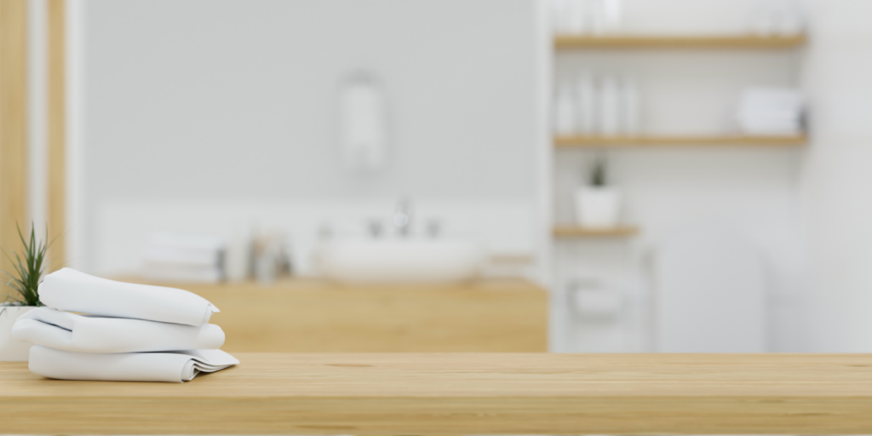
5. Stainless Steel Kitchen Countertops
Commercial kitchen countertops are well known for having stainless-steel countertops, and often, even the cabinets are stainless steel.
Kitchen countertops for restaurants and cafeterias are typically stainless steel for many reasons, some of which include their practicality, long-lasting durability, and that they’re easy to clean.
Stainless steel also has sanitary properties, meaning harsh chemicals aren’t needed for cleaning.
Recently the demand for stainless steel countertops has increased in home kitchens. They provide a sleek modern look when combined with natural materials like wood or stone. Plus, the contrast goes well together and makes the kitchen stand out from many others.
Pros
- Stainless steel is one of the countertop materials with the most heat resistance
- It’s a neutral colour so it pairs well with any cabinetry
- Easy to keep clean and requires little maintenance
- Will last about 25 years
- Stainless steel is not a porous material, so foods and liquids unable to absorb into the surface
- Doesn’t rust or stain
Cons
- It’s one of the pricier options for countertop materials
- Can make a kitchen feel somewhat ‘cold’
- Smudges and scratches are seen easily
- Stainless steel kitchen countertops are known to be ‘noisy’
Get a more detailed picture of the pros and cons in this article by bhg.com.

6. Zinc Kitchen Countertops
Zinc is a soft, reactive metal known for its ‘living’ finish. It reacts with water, fingerprints, sunlight, and acidic foods (like lemon juice), and affects its appearance. Eventually, the marks blend together and cause the zinc to develop a dark blue-gray patina finish.
Every zinc countertop has its own unique look because no two zinc countertops are the exact same due to their reactive quality.
Pros
- Easy to clean
- Foods and liquids unable to absorb into the surface
- Features an aged, natural look.
- Malleability; because of how soft zinc is, it’s highly customizable. Fabricators can build/integrate a zinc sink directly into the kitchen countertop.
- It’s a ‘living metal’ that changes colour over time in reaction to its surroundings.
Cons
- Zinc is high-priced
- It’s soft and scratches easily
- Zinc is heat intolerant; heat can warp the countertop material, and items over 300 degrees Fahrenheit can melt it.
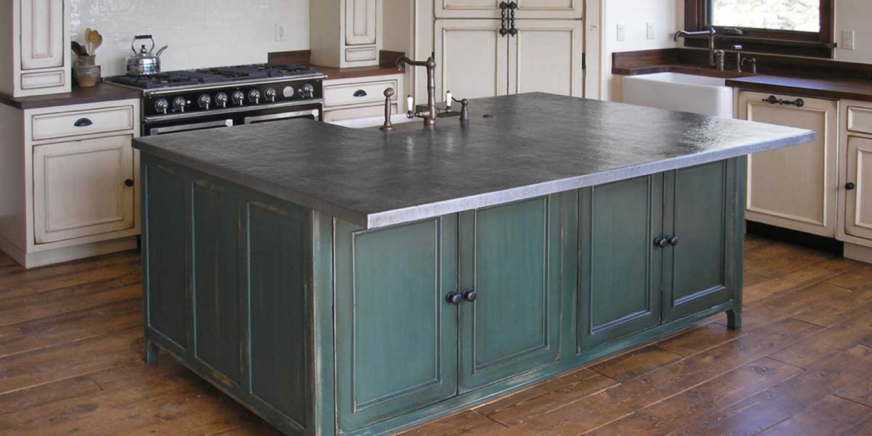
Source: handcraftedmetal.com
7. Epoxy Kitchen Countertops
Epoxy is perfect for DIYers who want to refinish their existing bath or kitchen countertops. It’s perfect for restoring or revitalizing old, worn, or out-of-style countertops. Epoxy can be used for more than just creating solid surface countertops, it’s used for floors and walls as well.
Epoxy is quite versatile and can be poured and bonded to materials like wood, concrete, metal, and so on and create a smooth, non-porous surface.
When using it over fillers and ‘underlayers’, the epoxy (which is already strong) becomes even more durable making it virtually indestructible after it’s dry and cured. The common name used for these kitchen countertops is “solid surface countertops.”
Pros
- Provides a durable resin finish
- Strengthens the underlayer countertop materials
- High-gloss finish
- Seamless
- Is resistant to heat – but not heatproof
- Nontoxic and food-safe
- Easy to clean and low maintenance
- Easy to refinish by sanding and polishing
- Can act as a sealer for concrete or quartzite (quartzite and quartz countertops are two different materials)
Cons
- Challenging and messy to apply
- Prone to stains
- Doesn’t work well with some natural stone materials like granite or marble
- No second chances, epoxy is very unforgiving that way.
If you want to know more about what epoxy is, have a read in this deep-dive article about epoxy countertops.

Source: emperorepoxy.com
8. Quartz Countertops
There is much confusion around whether quartz is natural or man-made, and that comes from the fact that the main component (quartz) itself is a natural mineral and gets engineered by man to produce quartz countertops.
So, basically, quartz gets ground to dust and is combined with other natural and synthetic materials such as polymers, resins, and pigments to create beautiful kitchen countertops.
Quartz countertops are among some of the most popular countertop materials in today’s kitchens.
The natural quartz mineral makes up about 90% of the final product, with the rest of the 10% being polymers and resins to bind the quartz together. Quartz is a non-porous, hard, durable, and long-lasting material due to the engineered final product.
Pros
- Quartz countertops have nearly unlimited colours and design patterns available. It’s sometimes even used to imitate granite or marble countertops.
- Basically a maintenance-free countertop due to its non-porous surface. Simple cleaning is all that’s needed.
- Durable and long-lasting
- Stain resistant
- Consistent appearance
- Resistant to heat
Cons
- Quartz kitchen countertops are considered a luxury option and typically cost more than natural stone options like marble or granite countertops
- Susceptible to heat damage
- Difficult to install
- Made for indoor use only

9. Quartzite Kitchen Countertops
In contrast to quartz countertops, quartzite countertops are all natural stone covered by a sealant and come in shades of white or light grey, with minerals in the stone lending pink, gold, or reddish-brown hues.
Quartzite is made from sandstone and sparkly quartz crystals which get fused together through heat and pressure to create quartzite.
Most quartzite is too porous in its raw form to use as a kitchen countertop material. So, polyurethane, wax, or acrylic is typically applied to seal the quartzite and create a non-porous kitchen countertop.
Pros
- Durability
- Easy to maintain
- UV resistant; great for outdoor kitchens
- Scratch resistant
- Relatively affordable
Cons
- Is not heat resistance
- Not many colours choices
- Not stain resistant
- Difficult to install

Source: thespruce.com
10. Marble Countertops
Marble is likely material that’s among the top 3 luxurious materials for kitchen countertops, and yet it’s actually limestone that’s been naturally transformed by intense heat and pressure. During the transformation, the minerals settle and create veins that give marble its distinct look.
There’s no shortage of supply of marble in the world but it’s more abundant in Italy, China, India, and Spain.
Marble countertops are made by starting with a large slab of marble stone which is cut to size using a specialized saw. Afterwards, it gets polished using various abrasive grits. Pads with finer grits give marble countertops a shinier look, while pads with larger grits give a softer natural look.
As it turns out, as beautiful as marble countertops are, they also have their price. So if the budget is a little tighter, you can choose to opt for marble tiles instead, which are a little more budget-friendly.
Pros
- Timeless look
- Natural stone
- Long Lifespan
- Surface stays cool
- Simple clean up
- Multiple finishes: polished, honed, sandblasted
- Edge profiles can be shaped in various ways
Cons
- High maintenance
- Higher price – not as affordable as most other natural stone countertops.
- Difficult to install
- Scratches and chips easily
- Easy to stain (its pores can absorb liquid)
- Difficult to repair
- Visible seams (if countertops are large enough you might need 2 slabs)
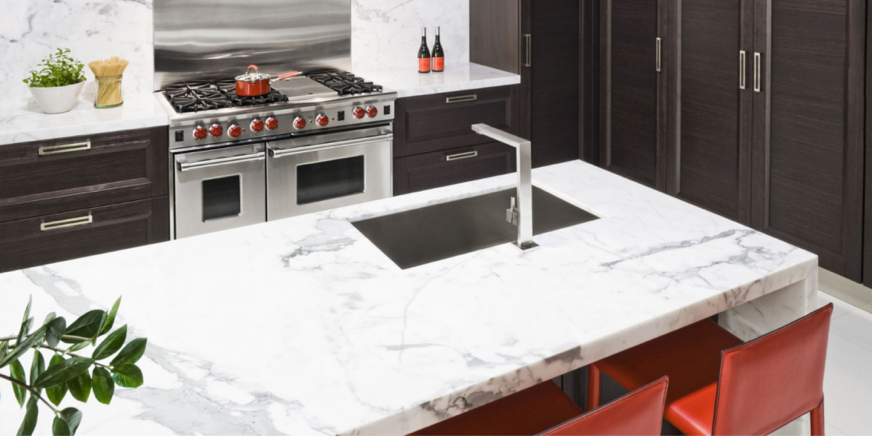
Source: housebeautiful.com
11. Granite Countertops
About 100 years ago, granite countertops first showed up, and they were only available to the wealthy. That’s because granite countertops cost far more than the average person could afford, and so they were only able to obtain them 50 years later.
Granite countertops are still considered a luxury product, even today, and they’re just as popular as they used to be in the ‘70s.
Granite countertops are 100% natural rock (with nothing added) that gets removed from quarries as huge blocks and sliced into sheets to fit custom kitchens.
Pros
- Natural material and appearance
- Resistant to heat
- Scratch resistant
- Stain resistant
- Low maintenance
- Granite countertops don’t depreciate in value
Cons
- The cost of granite countertops is typically more than most other natural stone countertops (similar in price to marble countertops)
- Granite countertops are difficult to install due to their weight
- Often requires additional structural support due to the weight
- Damage to cabinets is possible if removed due to glue
- Visible seams (assuming the kitchen is large enough to need 2+ slabs
- Prone to cracking and fading

12. Soapstone Kitchen Countertops
Soapstone, also called steatite or soaprock, is a natural stone (metamorphic rock) made mostly of talc, which is a clay mineral.
A rock will only be classified as soapstone if it contains at least 35-75% pure talc. The remaining material contains bits of chlorite, micas, amphiboles, carbonates, and other minerals like magnesium, silicate, etc.
Soapstone was named after its soapy feel, it’s also soft and has a smooth surface as soap does.
Because of how soft soapstone is, it’s easy to carve. It’s also been used for thousands of years to make cookware and sculptures. However, the soapstone used for countertops is harder than the type used by artists, which is called architectural soapstone and contains less talc.
Pros
- Non-Porous material
- Natural material (eco-friendly)
- Heat tolerant up to 2966°F
- Stain resistant
- Durable
- Easy to repair by sanding away dents and scratches
- Long lifespan
- Low maintenance
Cons
- Prone to dents and scratches
- Limited colour options
- Visible seams if the kitchen is large enough to need 2+ slabs
- High price
- Wears unevenly (most used areas colour fade more quickly)
If you want to dive deeper into the subject of soapstone countertops and their pros and cons, feel free to read up on this soapstone countertops blog post by forbes.com.
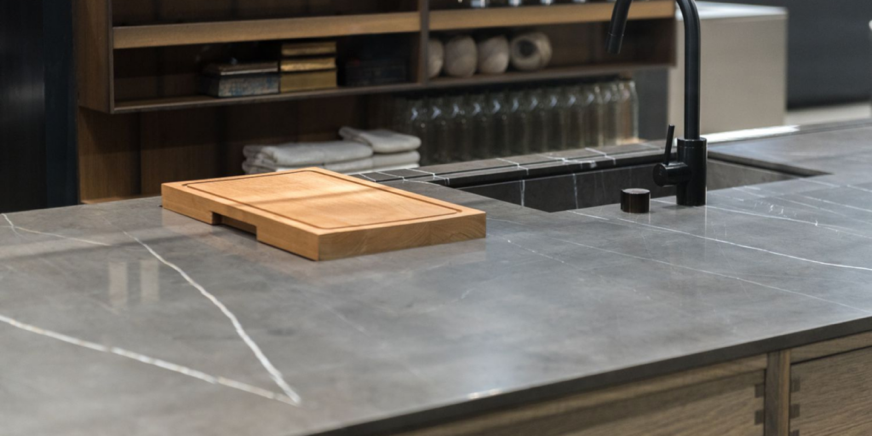
Source: thespruce.com
13. Concrete Countertops
There is a huge misunderstanding about what can be done with concrete countertops. They used to be just a gray slab…but not anymore. Today, concrete countertops can be painted, stained, or coloured internally.
When it comes to colour design, concrete will most likely be the one countertop that you can be most creative with.
Concrete is a porous material so it’ll need to be sealed with a food-safe sealer after the creative stage.
Concrete countertops are heavier than most other materials so additional structural support might need to be added due to the weight. Cracking and breaking are also easily possible with Concrete so it’s reinforced with rebar, fiber reinforcement, or wire mesh.
Pros
- Long-lasting and durable
- Creativity with painting, staining, or colouring internally
- The shape can be customized to any desired shape
- Difficult to scratch
- Impervious to heat
Cons
- Prone to chipping
- Prone to staining if it’s not sealed with a food-safe sealer.
- Often requires additional structural support due to the weight
- Pricey
- Consistent upkeep and resealing are required to avoid staining
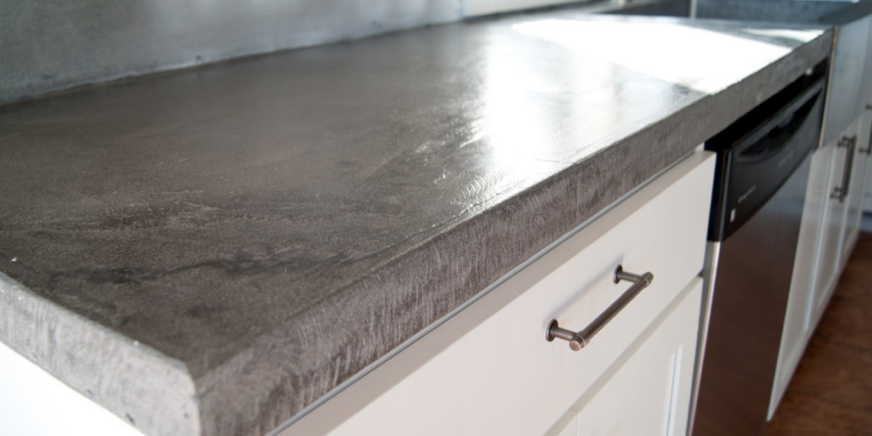
Source: u-cart.ca
14. Slate Kitchen Countertops
Whenever stone countertops come to mind, people think of granite, marble, and a little less popular soapstone. Slate, however, is one that’s cheaper, just as beautiful, and often forgotten.
So if you’re on a budget but want a stone countertop, slate is on the menu. Slate is a metamorphic rock composed of clay, shale, and quartz.
Taking thin slices of slate and gluing them together is how slate countertops are made. Slate is easier to maintain, unlike marble or granite, because it’s a non-porous material.
Pros
- Easy to clean
- Stain resistant
- Doesn’t require sealing (non-porous material)
- Heat resistant
- Hard and durable
- Seams are less visible
Cons
- Prone to chipping
- Scratches easily
- Cannot be polished to a glossy shine.
- Limited colour options
Read more about slate countertops in this article by denverstoneplus.com.
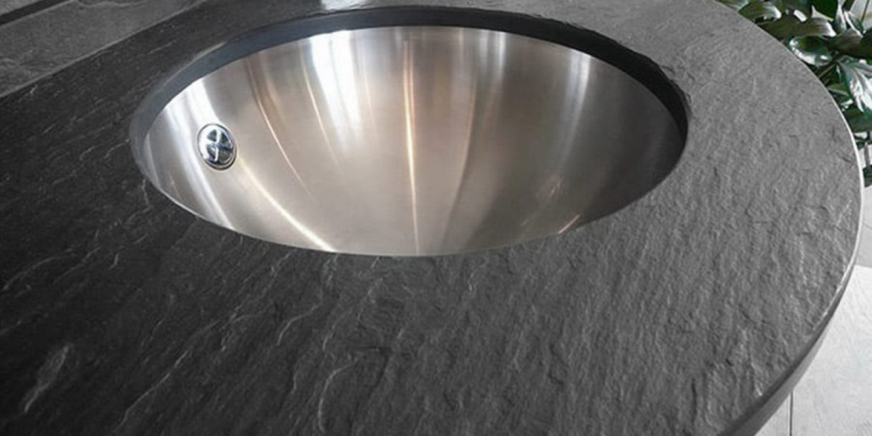
Source: goinggranite.com
15. Ceramic Tile Countertops
Ceramic tiles are more commonly used for flooring, in bathrooms and kitchen backsplash, but they make a great option as a countertop surface because of the endless creative possibilities.
Tile countertops are also great for 2 more reasons; they’re do-it-yourself friendly as well as budget-friendly.
Pros
- Heat resistant
- Endless custom design options
- DIY friendly
- Tile countertops are super Budget-friendly
- Easy to fix (ability to replace a single tile if needed)
Cons
- Prone to chipping and cracking if something heavy is accidentally dropped on the surface.
- Grout is susceptible to staining.
- Tough to clean
- Often an uneven surface
If you’re a DIYer and want to learn more about these, read this article about ceramic tile countertops.
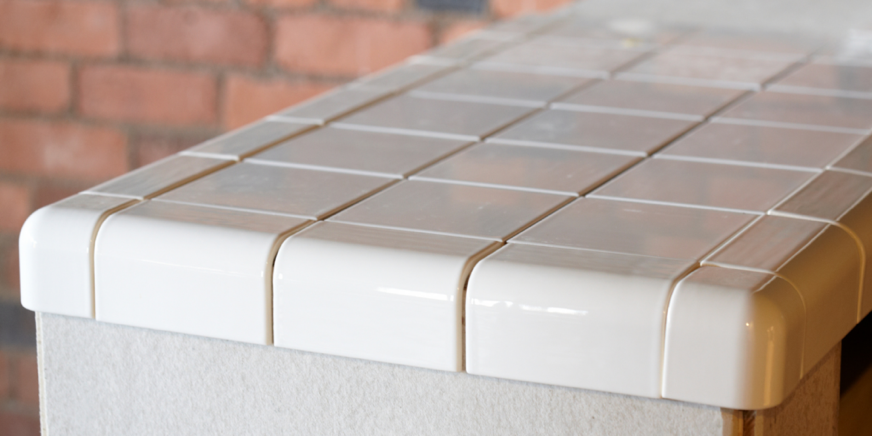
16. Porcelain Kitchen Countertops
When you think of countertops in terms of durability, porcelain countertops are probably one of the last types of countertop materials that come to mind, and yet it’s stronger than granite and almost as hard as quartz.
To make porcelain, a mix of powdered China stone and white China clay (kaolin) is heated at around 1450°C. The high temperature causes the powdered stone to form a dense and highly durable material, while the kaolin helps retain its shape. Exposure to such a high temperature helps make the porcelain resistant to stains, heat, UV rays, and scratching.
The clay has a few impurities such as silica, mineral oxides, and feldspars, adding strength and colour to the porcelain. When porcelain slabs are manufactured for countertops, they get coated with a pigmented glaze, making the porcelain countertops look similar to natural stone or even marble.
Pros
- Heat resistant
- Durable and hard
- Impervious to water (non-porous material)
- Low maintenance
- UV light resistance
- Scratch resistant
- Stain resistant
- Eco-friendly and recyclable material
Cons
- Patterns are printed so if the glazed portion chips, your design gets damaged
- Costly
- Limited edge style options
- Heavy (often requires additional structural support due to the weight)
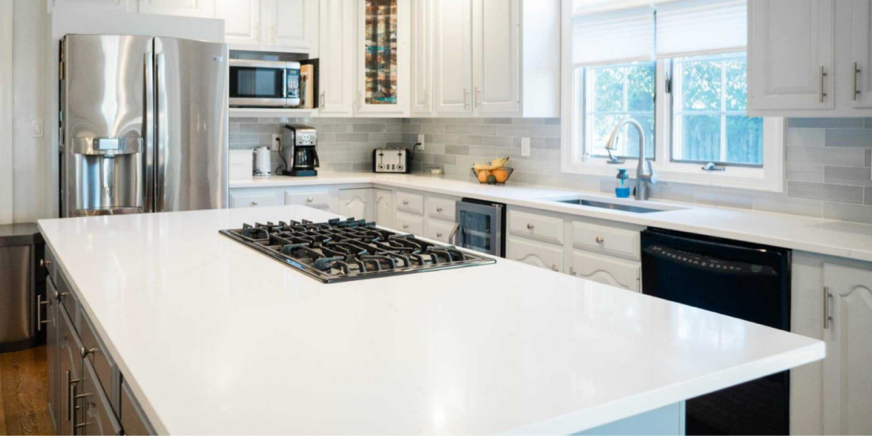
Source: exploregranitecountertops.com
17. Glass Kitchen Countertops
Glass countertops have become popular very quickly in recent years because of the versatility in colour and design and the beauty combo they bring. Available in almost any shape, colour and size you can imagine, glass countertops add style and elegance to any kitchen.
The many different styles range from back-painted glass, textured glass and even glass with LED lighting. Crushed glass is one more option, and we’ll talk about this one next.
The best part about glass countertops is that they’re far more durable and last longer than the majority of people think.
Pros
- Versatile in colour, finish, texture, and even lighting can be added
- Highly customizable
- Durable
- Heat resistant
- Stain resistant
- Low Maintenance
- Eco-friendly (recyclable)
Cons
- Cracking, scratching, or chipping is possible with sharp objects
- Difficult to repair
- Highly-priced
- Smudges and fingerprints can easily be seen
- Textured surfaces are harder to clean

18. Recycled (Crushed) Glass Kitchen Countertops
Recycled or crushed glass countertops have become more and more popular in recent years.
They’re made by putting crushed glass pieces into a binding cement or resin-based matrix. Similar to how quartz countertops are made.
Crushed glass countertops in a cement base give a classic mosaic art feel to them, while resin-based glass countertops give off the impression of floating glass chunks.
These are much different from regular glass countertops, which are made of a single piece of glass.
Pros
- Eco-friendly
- Unique in style
- Easy to clean
- Heat resistant
- Durable and long-lasting
Cons
- Not that cheap in price
- Potential for glass chips to get knocked loose
- The cement base needs resealing regularly
- Not DIY-friendly

Source: blog.vetrazzo.com
19. Recycled Paper Countertops
Recycled paper countertops – also known as paper stone – are made by mixing recycled paper and phenolic resin, which is an eco-friendly, stone-like material.
To compare it to other materials, one could say that it has the worm texture of wooden countertops and the stiffness of a soapstone countertop.
The best part about paper stone countertops is that they’re one of the most eco-friendly options out there.
Pros
- High density
- Durable
- Easy to fix (by a professional using a special filling)
- Eco-friendly
- Competitive pricing
Cons
- Strong cleaning chemicals will damage the surface or cause fading
- Limited light colours
- Colour won’t last nearly as long as stone counters
- UV rays can cause damage
- Susceptible to scratching
- Can scorch easier than any other countertop out there

Source: icestoneusa.com
20. Recycled Aluminum Countertops
Recycled aluminum countertops are most likely the least popular of all the countertops out there, but that’s because they don’t fit every style of kitchen, and they aren’t sold over the counter – they’re usually specially made.
Aluminum is mostly recycled using drink cans, but the industrial sector leaves a lot of aluminum scrap behind as well.
Similar to crushed glass countertops, recycled aluminum countertops are made by using shards of aluminum in a binding resin.
Pros
- Eco-friendly
- Unique in style
- Easy to clean
- Heat resistant
- Durable and long-lasting
Cons
- Not that cheap in price
- Not DIY-friendly
- Only one design (only the resin can be coloured)
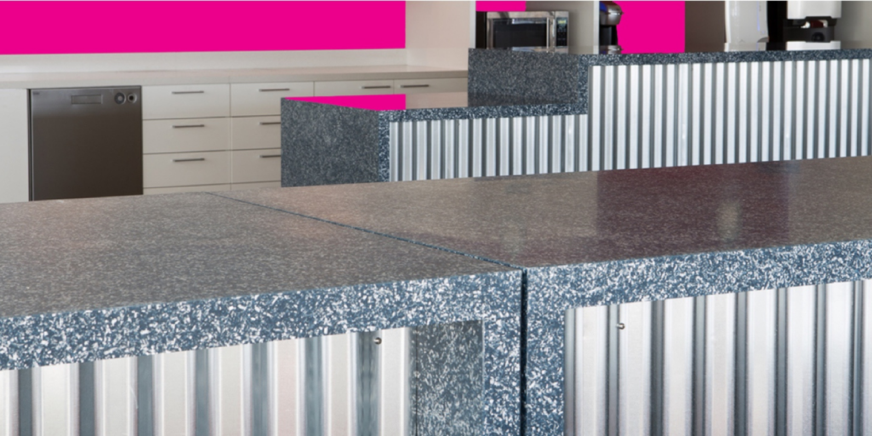
Final Thoughts
One of the most important aspects of kitchen and bathroom design is choosing the right countertop! You want this to be an investment that lasts many years and both your style and your lifestyle will help with choosing the right type of countertop for your home.
Every type of countertop has its pros and cons regarding hardness and durability, as well as heat and stain resistance. Just ask yourself; would it bother you if your countertop had a small crack in it?
Regarding design, you’ll need to decide whether you want natural stone or wood, or if a manufactured, composite material would be better.
You’ll then need to factor in the overall design of the room so you can be sure the countertop you love will work harmoniously with the cabinets, flooring, and other design choices.
With all that in mind, we hope this article has helped you understand what countertops are out there, what they’re made of and the pros and cons of each.

